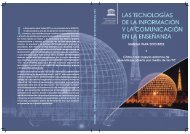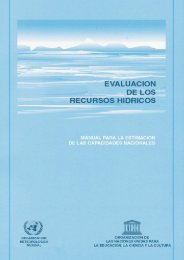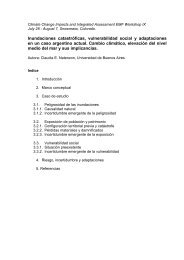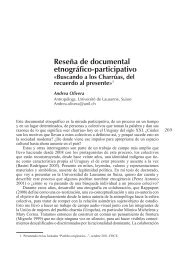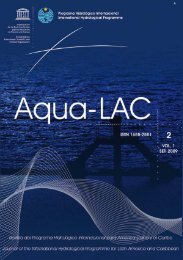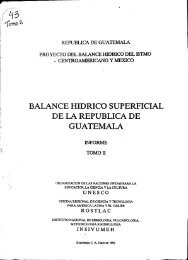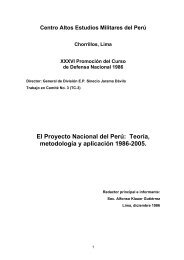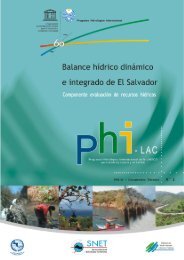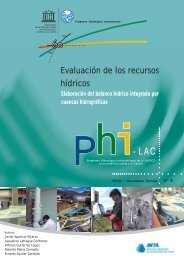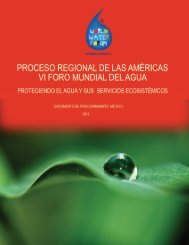ST13-Estrategia para el manejo de suelos.pdf - Unesco
ST13-Estrategia para el manejo de suelos.pdf - Unesco
ST13-Estrategia para el manejo de suelos.pdf - Unesco
You also want an ePaper? Increase the reach of your titles
YUMPU automatically turns print PDFs into web optimized ePapers that Google loves.
SUMMARY<br />
In or<strong>de</strong>r to improve catchment management, it is necessary: 1) to un<strong>de</strong>rstand both the physical<br />
characteristics (such as morphological and r<strong>el</strong>ief features, climatic characteristics, soils and<br />
land use or land cover), and the socio-economic characteristics of the catchment; 2) to be able<br />
to predict objectiv<strong>el</strong>y the catchment’s response to a major (especially extreme) rainfall or<br />
sud<strong>de</strong>n snowm<strong>el</strong>t event; 3) to un<strong>de</strong>rstand the current physical and socioeconomic state of the<br />
catchment, consi<strong>de</strong>ring: a) its potential production and <strong>de</strong>v<strong>el</strong>opment possibilities, and b) its<br />
characteristic stresses and current <strong>de</strong>gradation processes; 4) to set up clearly the aims to be<br />
achieved through the adopted improvement measures; and 5) to un<strong>de</strong>rstand the appropriate<br />
improvement techniques and their performance. All these aspects have been <strong>de</strong>v<strong>el</strong>oped as<br />
strategies in this Guid<strong>el</strong>ines for improved catchment management.<br />
The document begins (Section 1) by <strong>de</strong>fining the main effects that major rainfall events can<br />
produce in a catchment, and their possible impacts on human populations. The origins are<br />
<strong>de</strong>scribed of traditional Water & Forest Management measures for protecting against such<br />
events and for maintaining a sustainable land use in the catchment. A state-of-the-art review<br />
is presented of the most appropriate measures and techniques for catchment Water & Forest<br />
Management and Restoration in different natural scenarios, based on <strong>el</strong>evation, r<strong>el</strong>ief and<br />
potential vegetation.<br />
In Section 2, the role of forests in the water and sediment cycles, and their potential for<br />
controlling the impacts of erosion, sediment transport and flood flows resulting from major<br />
rainfall events are analyzed. Also the effect of forests on water resources availability and<br />
supply during the periods between extreme events is assessed.<br />
In the third section, the framework of Water & Agricultural Management and Water & Forest<br />
Restoration within the EPIC FORCE Project is presented. Specific aspects of both concepts<br />
are explained and the main objectives are i<strong>de</strong>ntified as: 1) catchment protection, to reduce the<br />
flood and sediment effects that could be produced by major rainfall events, both mo<strong>de</strong>rate and<br />
extreme, or sud<strong>de</strong>n snowm<strong>el</strong>t; and 2) optimal management of water and land resources use in<br />
the catchment, i.e., its sustainable use.<br />
In the fourth section, the economic analysis of a catchment’s Water & Agricultural<br />
Management is consi<strong>de</strong>red in the context of the foregoing objectives, i.e.: 1) catchment<br />
protection; and 2) the sustainable use of resources.<br />
Section 5 is focused on a pr<strong>el</strong>iminary application of the Water & Agricultural Management<br />
framework within the EPIC FORCE Project, for different Latin American catchments located<br />
in different geographic environments. The Río Pejibaye (Costa Rica) and Río Chanchán and<br />
its tributary Río Guabalcón (Ecuador) catchments represent the intermediate and high<br />
mountain tropical area of Latin America; and the Buena Esperanza stream catchment, located<br />
in Tierra <strong>de</strong> Fuego (Argentina), represents the An<strong>de</strong>an-Patagonian region. In addition, best<br />
practices for the management of fast-growth forest plantation in the Valdivia region of Chile<br />
are reviewed, in support of environmental certification for forestry operations.<br />
The document closes with a set of conclusions and recommendations, amongst which, must<br />
be highlighted one that rejects the traditional wisdom: that forest protects against every<br />
torrential event or, more clearly, the lack of forest is the cause of every disaster and loss.<br />
Forests protect efficiently against the predictable effects of mo<strong>de</strong>rate events (i.e., those with<br />
III



